
From the publisher:
“Goethe once wrote, “Everything is both simpler than we can imagine, and more complicated than we can conceive.” He could well have had chess endgames in mind. Endgames have fewer pieces on the board than middlegames but this does not necessarily make them “easier” to play or understand.
Tactical expertise is, understandably, generally associated with middlegame (and sometimes opening) positions. However, tactics are also crucial in endgames – a point that is sometimes overlooked. Even some quite simple looking pawn endgames can feature complex tactical ideas. Tactics in endgames also tend to be very different to middlegame tactics.
As well as the familiar themes of pins, skewers and forks, endgames also feature unique concepts that rarely occur in middlegames such as pawn breakthroughs, manoeuvring for zugzwang and active use of the king as an aggressive unit.
In this book the highly experienced chess author and coach Cyrus Lakdawala guides the reader through the complexities of endgame tactical play. Lakdawala assembles positions that are most effective to improve tactical ability. Work your way through this book and you will undoubtedly see the results in your own games.”
end of blurb…
“Cyrus Lakdawala is an International Master, a former National Open and American Open Champion, and a six-time State Champion. He has been teaching chess for over 30 years, and coaches some of the top junior players in the U.S.”
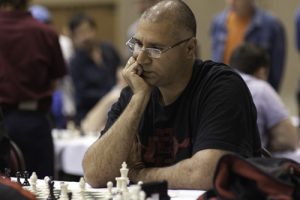
Here is an extract in pdf format.
The reviewer is a fan of this type of book which is a really good endgame puzzle/training tome: this title does not disappoint. The examples are a pleasing mixture of endgames from high level games; composed studies and a final chapter consisting of composed mate in two problems.
In the introduction, the author addresses the common objection to studies and problems “they are artificial and also too difficult”. He recalls a piece of advice from GM Bill Lombardy: “You don’t have to solve them. Just try for a few minutes and then look up the answer.” This is the point, the act of attempting to solve the study/problem followed by a close study of the answer will improve your analytic ability and enlarge your toolbox of recognised patterns. A lot of studies have very memorable moves/themes which once seen are never forgotten.
The reviewer can recall a particular knight and pawn endgame where I jeopardised an easy draw by missing a study like move (lack of imagination in cruise mode) but redeemed myself by scrambling a study like draw (desperation but only found because my imagination had been improved by studying studies).
Cyrus goes on to discuss training techniques to improve students’ calculation skills, tactical awareness and tactical/strategic imagination: he and the vast majority of trainers regard studies as an essential tool to aid the development of endgame mastery.
In the main seven chapters, I like the way the author breaks down the more difficult studies to aid a student/reader to solve them: it’s almost like a brain dump of his assessment/analysis process as he goes about solving the problem.
The over the board endgames include many games from masters of the endgame such as Botvinnik, Capablanca, Karpov, Smyslov, and Tal. Tal may not be immediately recognised by some as a maestro of the endgame, but his calculation skills and imagination were second to none and this made him a superb endgame player.
The studies include giants such as Afek, Grigoriev, Mitrofanov, Pogosyants, Réti, Troitzky.
The book is divided into eight chapters, the first two sections are kind of introductory followed by five chapters with different piece combinations. The final section is a set of mate in two problems.
The reviewer will showcase three or four positions from each chapter to give the reader a taster.
Here are some interesting positions from Chapter One – Deadly Simplicity.

This position is from the game Chigorin v Tarrasch Ostend 1905. White looks to be in terrible trouble here as black’s king is going to outflank white’s king and win material.
White played the resigned 50.gxf6 and lost shortly. However, white does have a dastardly defence which once seen is always remembered. 50.Kg4!! Ke4 51.g6! Now white creates a stalemate defence or he can create a future passed pawn. 51…hxg6 (51…h6 52.Kh5! and the f-pawn cannot be captured as it is stalemate!)

52.fxg6 f5+ 53.Kg5 f4 54.h5 f3 55.h6
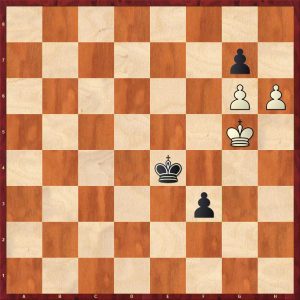
55…gxh6+ 56.Kh6 f2 57.g7 f1Q 58.g8Q drawn
Next I shall show a lovely study which looks deceptively simple!

White to play and win.
The obvious approach to black’s pawn such as 1.Kf4? or 1. Ke5? fails to 1…Kc4 2.Kg5 Kd3 3.Kxg6 Ke4 and black gobbles the f-pawn to draw. 1.Kd5? looks tempting to shoulder barge the black king, however 1…Kb4! draws 2.Ke5 (2.f4 Kc3! draws is a major point) Kc4 3.Kf6 Kd4 4.Kxg6 Ke4 draws.
1.Kd4!! is the only way preventing the side approach, now 1…Kb4 (1…Kc6 2.Ke5 Kd7 3.Kf6 wins) 2.f4! The key point 2..Kb3 3.Ke5 Kc4 4.Kf6 wins
A really instructive problem and very game like.
The next study is white to play and win. I remember being shown this study as a kid and solving it.
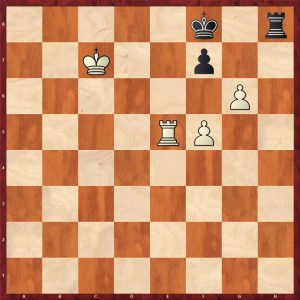
1.Re8+ !! (1…Kg7 2.f6+ wins black’s rook) 1…Kxe8 2.g7 Rg8 3.f6 Zugzwang 3…Rf8 4.exf8Q+ Kxf8 5.Kd7 Kg8 6.Ke7 and wins the f-pawn and the game.
Chapter 2 – Recognizing Patterns

What is happening here with white to play? White can draw easily with 1.Rxe7 or 1.gxf7. Can white do better?
1.f6 looks interesting with the idea of 1…Rxe8 2.gxf7

Surely white is winning with 3.fxg7 to follow after black moves his rook. But analyse further! 2…Rd8!! wins as after 3.fxg7 Ke7!+ wins both pawns and the game. Cyrus had set this position as an exercise for some students, most of whom complained bitterly when they fell into the trap. The author responded that he did not specify a “white to play and win” position, he just gave them a position to analyse, just like a game! A great learning experience.
Here is a didactic opposite coloured bishop endgame.

How does white make progress here? 51.Be7 allows Kc7 blocking the king’s path into black’s position. 51.Bb8! does the trick and black resigned 1-0. If 51…Kxb8 52.Kd6 Kc8 53.Kxe6! Kd8 54.Kf6 Kd7 55.Kg7 Ke7 56.Kxh7 Kf7 57.e6+ decoying the black king, winning after 58.Kg7 and 59.h7
Here is some Troitzky magic: white to play and draw.
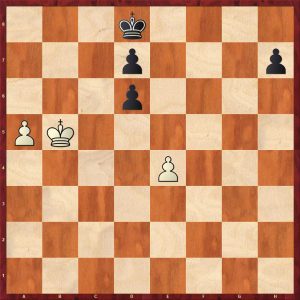
White looks to be in desperate straits as the black’s outside passed h-pawn looks to be the decisive factor.
1.Kb6! threatening 2.a6 1…Kc8 2.a6 Kb8 3.a7+! Ka8 4.Kc7! h5 5.Kxd6 h4 6.Kxd7 h3 7.e5 h2 8.e6 h1Q 9.e7 Qd5+ This looks lost for white as an e-pawn on the seventh normally loses against a queen 10.Kc7! Qe6 11.Kd8 Qd6+ 12.Kc8! Qxe7 stalemate
Chapter 3 – King And Pawn Endgames
Here is an important idea that does occur in practice. Alexei Shirov lost a game to this idea.

This position looks to be drawn after a move like 1.Rg1 a1=Q as white wins both pawns but black’s king gets back in time to secure the draw. However white has an elegant idea to win: 1.Ra1! Kxa1 Forced as 1…Kb3 2.Kc1 Ka3 3.Kc2 wins the a-pawn and the game easily 2.Kc2 Zugzwang 2…g5 3.hxg5 h4 4.g6 h3 5.g7 h2 6.g8Q h1Q 7.Qg7#
Here is a famous finish to a game demonstrating the potential power of a breakthrough and Reti’s theme with king paths.

White looks to be lost as after 1.Kf6 c4 2.bxc4 bxc4 3.Ke5 c3! 4.bxc3 a4 the black pawn promotes. 1.Kg6!! threatening h5 forces 1…Kxh4 2. Kf5 Kg3 3.Ke4 Kf2 4.Kd5 Ke3!

5.Kxc5 Kd3 6.Kxb5 Kc2 7.Kxa5 Kxb3 draw (A really instructive endgame lesson – kings do not have to take the most obvious path.)
Some Vasily Smyslov magic next.

White had had a vastly superior (winning) rook ending and decided to enter this king and pawn ending which he assessed as easily winning for white as he has a potential passed outside h-pawn and his king can enter via c4. Smyslov shattered that illusion with 46…g4!! 47.h4 (47.hxg4 does not help as the potential passed pawn has disappeared and black’s king now can enter white’s position via g5 leading to a draw.) 47…c5 48.Ke2 Kh7! 49.Kd3 Kh6 waiting

50. c3 (white’s intended 50.Kc4 loses to the breakthrough move 50…f5! 51.exf5 e4! 52.c3 a5! zugzwang and the e-pawn promotes) 50…a5 51.cxb4 axb4 drawn (A brilliant escape for the endgame master)
Chapter 4 – Rook Endgames
A famous study but worth reproducing called Lasker’s manoeuvre/steps/ladder. This has occurred in practice in GM games.
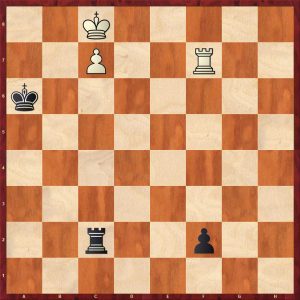
1.Kb8! Rb2+ 2.Ka8 Rc3 3.Rf6+ Ka5 4.Kb8 Rb2+ 5.Ka7 Rc2+ 6.Rf5+ Ka4 7.Kb7 Rb2+ 8.Ka6 Rc2 9.Rf4+ Ka3 10.Kb6 Rb2+ 11.Ka5 Rc2 12.Rf3+ Kb2 13.Rxf2! (13.Kb6?? only draws 13…Kb1! 14.Rxf2 Rxf2 15.c8=Q Rb2+ drawing by perpetual) 13…Rxf2 14.c8=Q wins
Here is some more Troitzky magic which is very game like.
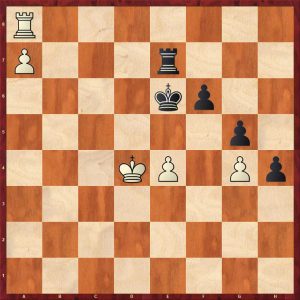
Black appears to be ok as his h-pawn should be enough to draw.
1.e5! fxe5+ (1…h3 2.exf6 wins as the black king will exposed to a decisive rook check) 2.Ke4! h3 3.Rh8! Rxa7 4.Rh6+ Ke7 5.Rh7+ securing the rook and the game. A very common idea in rook and pawn endgames.
Here is the end of a game Judit Polgar v Nigel Short Monte Carlo 1993.

This is instructive: 61.h6+! Kf7 (61…Kxh6 62.Kf6 wins threatening mate and the rook) 62.g5!! fxg5 63.Rd8! and black cannot stop the h-pawn without giving up the rook, 1-0 in a few moves after a few spite checks.
Chapter 5 – Queen Endgames
Queen endgames are notoriously tricky and complex.
Here is an entertaining study.
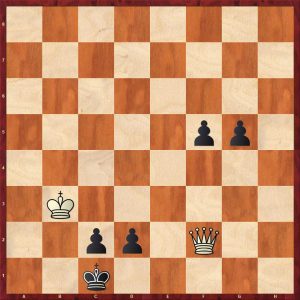
White looks to be in trouble as 1.Qe3!! is met by 1…f4 forcing promotion, but look further: 2.Qf2! d1=Q 3.Kc3!! zugzwang 3…f3 4.Qe3+ Kb1 5.Qb6+ Kc1 6.Qb2#
Here is an amusing study. How does white win here?

After 1.Qxg8+ Kxg8 white can play 2.h7+ which only leads to stalemate or 2.hxg7 and although white wins the a-pawn, black’s king reaches the a8 corner in time to draw.
1.Qh8!! Qxh8 2.h7 a3 3.Kd7 zugzwang 3…Qg8 forced 4.hxg8Q+ Kxg8

5.Ke7! Kh8 6.Kd6 Kg8 7.Kc5 Kf8 8.Kb4 Ke7 9.Kxa3 winning
Here is an amusing finish from a game Adams-Dimitrov.
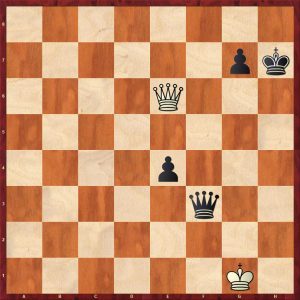
Black played 68…e3?? no doubt looking forward to a win over his illustrious opponent. Adams reply soon disabused him: 69.Qh3+! 69…Qxh3 stalemate (Lesson: the queen is powerful, always be on the look-out for mating and stalemating ideas)
Chapter 6 – Minor Piece Endgames
Here is a study by the great Grigoriev which shows a bad bishop endgame, but how does white breakthrough?
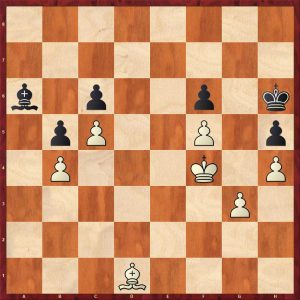
1.g4 creating a passed h-pawn does not win as white has no entry point for his king. So the only idea to win must be Bxh5 but white must prepare this move without allowing black’s bishop to get out of its cage.
1.Bf3 Bb7 2.Ke3! (2.Ke4? would allow black’s bishop to improve its posting 2…Bc8 and draws) Ba8 3.Ke4! Bb7 4.Kf4 Ba8 5.Bxh5! (Now black’s bishop is on its worst possible square) Kxh5 6.g4+ Kxh4 (6…Kh6 7.g5Kg7 8.h5 Bb7 9.h6+ Kf7 10.gxf6 Kxf6 11.h7! Kg7 12.Ke5 Kxh7 13.Kd6 winning) 7.g5 fxg5+ 8. Ke4! (8.Ke5 also wins but takes much longer) Kh5 (8…g4 9.f6 g3 10.Kf3! Kh3 11.f7 g2 12.f8Q g1Q 13.Qh8#) 9.Ke5! g4 10.f6 g3 11.f7 g2 12.f8Q g1Q 13.Qh8+ Kg4 14.Qg7+ winning the queen
Here is more Smyslov magic:

How does white breakthrough? Black looks to have a fortress.
1.b4!! axb4 (1…cxb4 2.Bxb6 b3 3.Kd3! Be1 4.c5 Bf2 5.Kc3 Kf5 6.Kxb3 Kxe5 7.Kc4 Kxf6 8.Bd8+ Ke5 9.Bxa5 f5 10.Bc3+ Ke4 11.a5 and white pawns are faster) 2.Bxc5! bxc5 (2…b3 3.Kd3 bxc5 transposes) 3.a5 b3 4.Kxd3 Bxf6 5.a6! winning
Here is an elegant study with some brutal counterplay that is brilliantly suppressed.

1.g7!! f2 2.Be7! f1Q 3.Bf6! Qxf6! 4.gxh8Q+ Qxh8
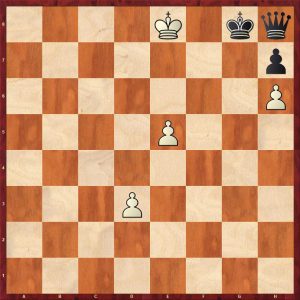
5.d4! zugzwang 5…Qg7 6.hxg7 h5 7.e6! h4 8.e7 h3 9.Kd7 h2 10.e8Q+ wins
Here is Botvinnik, the master at play.
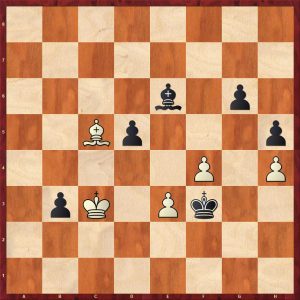
59…g5!! 60.fxg5 d4+! 61.exd4 Kg3 (The position below demonstrates the very important “one diagonal” principle in opposite coloured bishop endings. Black’s bishop fulfils two roles on one diagonal: protecting his own b3-pawn whilst simultaneously preventing the advance of white’s passed pawns.)
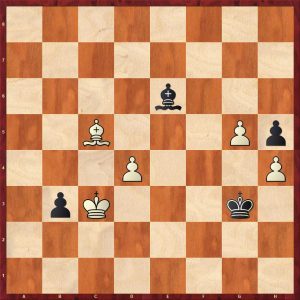
62.Ba3 Kxh4 63.Kd3 Kxg5 64.Ke4 h4 65.Kf3 Bd5+ 0-1 Black wins the bishop which has to give itself up for the h-pawn and then simply captures white’s pawns winning easily.
Chapter 7 All Other Piece Combinations
Tal – Trifunovic
Palma de Mallorca (5) 1966
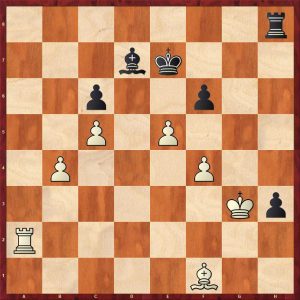
Tal had to seal in this position and he played the best move beginning a ten move combination.
45.e6! Bxe6 46.Ra7+ Bd7 47.Kh2 Rh5!
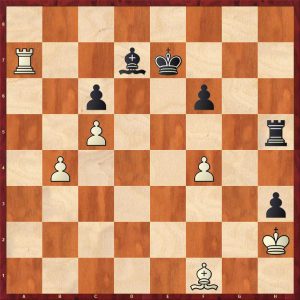
48.b5! Rxc5 49.Bxh3 f5 50.bxc6 Rxc6 51.Bxf5 Rd6 52.Kg3 Ke8
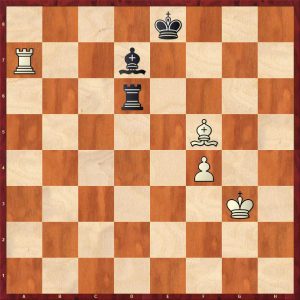
53.Rxd7! A neat simplification Rxd7 54.Bxd7+ Kxd7 55.Kg4 Ke6 56.Kg5 Kf7 57.Kf5 1-0
Here is a jointly composed study with one of the composers being Leopold Mitrofanov of Qg5!! fame. If the reader doesn’t know what I am on about, then look it up for a real treat – arguably one of the greatest studies ever.
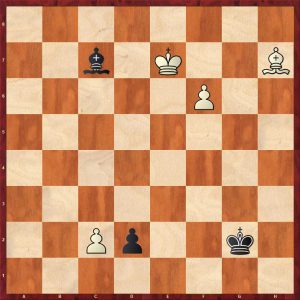
1.Be4+ Kg3 2.Bf3! Kxf3 3.f7 Bd6+ 4.Kxd6 d1Q+ 5.Kc7!! Qxc2+ 6.Kd7 drawing (Black’s king is one square too far from the winning zone.)
Here is a superb study by Yochanan Afek.

1.b7 Qc6 2.Bd7! Qxd7 3.Rxe4+ (These checks avoid black’s stalemate defences, I will leave the reader to work them out) Ka5 4.Re5+ Kb6! (4…Ka6? 5.b8N+ wins) 5.b8Q+ Ka6

White is threatened with mate and has no checks. 6.Rb5!! Qxb5 7.Qa7#
Chapter 8 Composed Mates In Two
Here is a problem – white to play and mate in two moves.

1.Qf1! There are four different mates. I shall leave the reader to figure them out.
In summary, an excellent endgame coaching/training manual to improve your analytic powers with some instructive, beautiful and entertaining games, studies and problems.

FM Richard Webb, Chineham, Hampshire, 27th July 2021
Book Details :
- Hardcover : 432 pages
- Publisher:Everyman Chess (23 July 2021)
- Language: English
- ISBN-10:1781945861
- ISBN-13:978-1781945889
- Product Dimensions: 17.02 x 23.5 cm
Official web site of Everyman Chess

